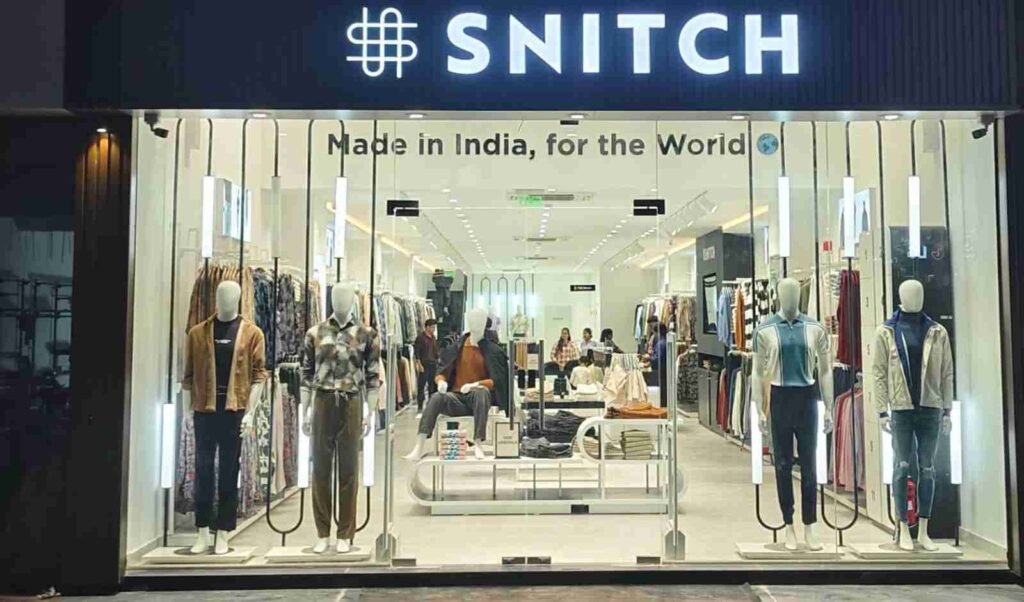When India shut down during the 2020 lockdown, most apparel manufacturers halted production, but Bengaluru-based entrepreneur Siddharth Dungarwal turned the crisis into an opportunity. With a few designs, one Shopify store, and a four-member team, he founded Snitch, a men’s fashion brand that grew from a desperate pandemic pivot into a ₹500 crore phenomenon within five years.
The Origins: From Supplier to Brand Visionary
Before Snitch came into existence, Siddharth spent nearly a decade running a buying house that supplied garments to well-known retail brands across India. One pivotal moment changed everything: a ₹300 shirt he manufactured for a client was being sold for ₹1,200 in stores. Realising he was doing the hard work while others reaped the rewards of brand and profit, Siddharth decided to create something of his own.
This awakening laid the foundation for Snitch, a brand built not just on manufacturing prowess but on control over design, speed, and consumer connection. By 2019, after years of manufacturing for giants like Arvind and Madura Fashions, he was ready to launch his own label.
Key Details:
| Category | Details |
|---|---|
| Brand Name | Snitch (Men’s Fashion Brand) |
| Founder & CEO | Siddharth Dungarwal |
| Founded | 2019 (Bengaluru, India) |
| Parent Type | D2C (Direct-to-Consumer) Omnichannel Menswear Brand |
| 2025 Valuation | ₹2,500 crore (approx. $294 million) |
| Estimated Net Worth (Brand) | Nearly $300 million (₹2,450–2,500 crore valuation post Series B) |
| Founder’s Estimated Net Worth | Around $290–300 million (approx. ₹2,400 crore), inclusive of holdings |
| Series B Funding (2025) | ₹340 crore ($40 million) led by 360 ONE Asset with participation from SWC Global & IvyCap Ventures |
| Series A Funding (2023) | ₹110 crore raised from SWC Global & IvyCap Ventures |
| Previous Valuation (2023) | ₹500 crore |
| FY24 Revenue | ₹243 crore |
| FY25 Operating Revenue | ₹520 crore (unaudited numbers) |
| FY26 Projected Revenue | ₹900 crore target (+80% growth expected) |
| FY24 Net Profit | ₹4.4 crore |
| FY25 EBITDA | ₹30 crore (approx. 5x YoY increase) |
| Projected FY26 Net Profit | ₹40 crore (estimated) |
| Gross Merchandise Value (GMV) | ₹600 crore annual run rate |
| Annual Growth Rate | 120% YoY (2024–2025) |
| Store Count (2025) | 60 active stores across India |
| Planned Expansion by 2026 | 100+ stores (80 owned, 20 franchised) |
| Offline Contribution | 45% of revenue (stores outperform online 2x AOVs) |
| Online Contribution | 55% of revenue |
| ASP (Average Selling Price) | ₹1,100 per item |
| Top Investor Stakeholders | 360 One Asset Management, SWC Global, IvyCap Ventures |
| Shark Tank India Debut | Raised ₹1.5 crore for 1.5% equity (₹100 crore valuation) |
| Target by FY30 | $500 million (₹4,100 crore) in annual revenue |
| IPO Plan | Aims to go public by 2028 |
Key Business Highlights
- Massive valuation surge: Snitch’s valuation skyrocketed from ₹500 crore in 2023 to ₹2,500 crore by mid-2025, a fivefold jump following its Series B round.
- Revenue Boom: In just five years, Snitch scaled from ₹11 crore in FY21 to ₹520 crore in FY25, maintaining profitability and doubling sales annually.
- Funding milestones: Over ₹450 crore raised cumulatively from investors across two major rounds (Series A + Series B).
- Retail Expansion: Company aims to open 125+ stores by 2026 and cross 300 stores by FY28 with a focus on Tier-1 and high-street locations.
- Upcoming IPO Goal: Snitch plans to go public within 3 years, targeting FY28 for its debut public listing.
- Diverse product categories: Focused mainly on Gen-Z and millennial menswear, Snitch has expanded to “Snitch+,” a plus-size line seeing 3–4X monthly demand growth.
- Operational efficiency: 80% of total sales now come from brand-owned channels, sharply reducing marketing costs by nearly 50%.
- Strong international ambitions: Plans to foray into global markets and quick commerce channels in 2026, using its fast fashion model to deliver new collections weekly.
The Birth of Snitch
Snitch launched in late 2019 as a B2B venture, serving offline retailers who rebranded its apparel under their own names. However, the COVID-19 pandemic upended physical retail operations. Orders were cancelled overnight, payments frozen, and unsold inventory piled up in warehouses.
Rather than waiting for the market to recover, Siddharth made a decisive move, selling directly to consumers. Snitch was reborn as a D2C (Direct-to-Consumer) brand on Shopify in mid-2020, launching with just 30 designs.
With limited resources and no prior marketing experience, this was an instinct-driven pivot focused on survival. Yet, it became one of Indian fashion’s most successful digital transformations.
Reinventing Men’s Fashion
Snitch thrived because it identified and solved a deep gap in India’s menswear market. Traditional brands like Van Heusen, Louis Philippe, and Allen Solly catered to formals and corporate styles, leaving a generation of young Indian men unrepresented.
Snitch embraced bold, fast, and expressive clothing, co-ords, oversized shirts, bright prints, and edgy fits, designed specifically for Indian physiques and aesthetics. Siddharth’s team focused on cut, comfort, and relatability, instantly capturing the attention of India’s Gen Z and millennial customers.
The Fast-Fashion Formula
Snitch’s success is powered by one core principle: speed. Traditional retail relies on long design cycles, often taking six months to bring new collections to market.
Snitch, in contrast, launches 35 new designs every day. Equipped with in-house designers and streamlined manufacturing, it turns concepts into products in under a month.
This agility allows Snitch to adapt to trends in real time, transforming social media cues, influencer styles, and pop culture movements into wearable fashion within days.
“We act fast and keep refining. The secret is not waiting for perfection, it’s about staying relevant,” Siddharth shared in an interview.
Data, Community, and Digital Discipline
Snitch’s aesthetic may be youthful and spontaneous, but its operations are rooted in analytical precision. Every product’s performance is reviewed daily. Items that don’t sell within ten days are removed, ensuring zero clutter and constant freshness.
Siddharth built his content and community strategy around young consumers. The brand’s creative team, all under 25, designs campaigns from their lived experiences, using Instagram, reels, and influencer collaborations to drive engagement.
Data-driven insights also inform Snitch’s inventory and assortment decisions. By tracking search queries and browsing behaviour, the company tailors new drops to demand, creating a feedback loop that drives both efficiency and customer delight.
The Shark Tank Moment
Snitch gained national recognition after appearing on Shark Tank India in 2023, securing an all-shark deal worth ₹1.5 crore. Beyond funding, the appearance validated Snitch’s brand power and drew nationwide attention.
Following the broadcast, sales skyrocketed, and Snitch’s customer base expanded beyond metro cities. Siddharth emphasised that the real gain wasn’t capital, it was credibility, trust, and the validation of Snitch’s vision to make everyday fashion accessible, bold, and local.
Explosive Growth: From 0 to 500 Crores
From ₹11 crore in FY21, Snitch’s net sales surged to ₹243 crore in FY24 and further crossed ₹500 crore in FY25, with an EBITDA of ₹30 crore. The brand remained profitable throughout, thanks to in-house production, aggressive cost management, and a focused omnichannel strategy.
Its online presence continues to attract 18 million sessions a month, while its offline footprint now includes 59+ stores nationwide, spanning high-street and mall outlets.
The opening of a store in any new city consistently triples local online sales, evidence of its omnichannel synergy. About 65% of revenue still comes from online channels, showcasing how digital remains Snitch’s backbone.

Innovation Beyond Apparel
Snitch has evolved into a complete lifestyle brand, offering over 5,000 SKUs, from shirts, jackets, and hoodies to perfumes, jewellery, and eyewear. Recently, it launched Snitch Plus, a plus-size fashion range to make its inclusive vision a reality.
The company also experiments with quick commerce, piloting 3-hour delivery models in Bengaluru through dark stores, adding convenience to speed.
Siddharth’s Philosophy: Hunger Over Hype
Siddharth believes Snitch’s success is rooted not in trends but in culture. “Zara isn’t my competition; my customers’ boredom is,” he remarked.
That mindset fuels constant innovation. Unlike traditional players bound by seasonal cycles, Snitch operates like a tech company, testing, analysing, and iterating continuously. Every collection is treated like a product launch, every marketing push like a sprint.
The Road to ₹1,000 Crores and Beyond
Looking ahead, Snitch aims to double its revenue to ₹1,000 crores by FY26 and go public by FY30. Siddharth plans to expand to 100+ stores by 2025, strengthen tech infrastructure, and foray into international markets such as the Middle East, the US, and the UK, leveraging growing diaspora demand.
The brand is also exploring franchising, targeting a 50-50 mix of company-owned and franchise-run outlets to optimise scale.
Snitch didn’t just follow trends; it created them.
What began as a survival move during lockdown has morphed into India’s loudest, fastest, and smartest fashion revolution, one that’s only just getting started.
